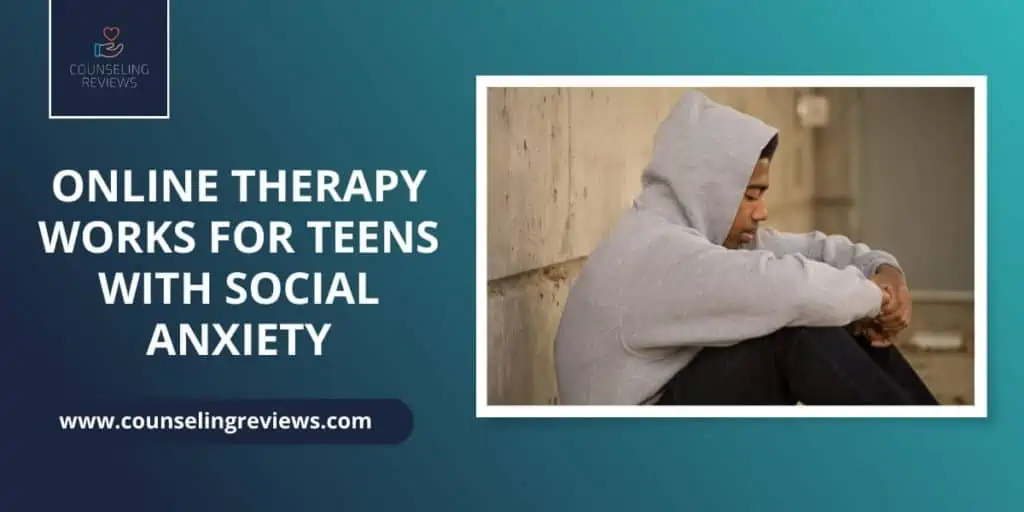When you think about the young generation, you think of energy, health, and a prospective future. Unfortunately, not every teenager is on a joyride through life.
Approximately 20% of adolescents aged 12 to 18, including teens with social anxiety, are affected by mental health disorders.
Social anxiety is manifested as social phobia, a deep, persistent fear that causes individuals to feel as if people are watching them and judging them all the time. It’s an intense fear that’s powerful enough to affect school, work, and the everyday activities of teenagers. Social anxiety can also make it tough to meet and make new friends, but fortunately, this state of mind is a treatable condition.
Keep reading to find out all about the key factors that cause social anxiety in teens. The most common symptoms that indicate your teen suffers from social anxiety, and how to overcome the issue with online therapy for teens to put an end to the troubling issues.
What is Social Anxiety?
Social anxiety is a type of anxiety disorder
Teenagers who suffer from social anxiety disorder experience symptoms of fear and anxiety in situations where they might be evaluated and judged by other people, such as answering questions in class, in school interviews, dating, meeting new people, and speaking in public.
Performing everyday activities like using public restrooms, eating, or drinking, can feed teens fear and anxiety due to worries about being rejected, judged, and humiliated.
How Severe is Social Anxiety?
The problems and the fears that teenagers with social anxiety disorder face in social situations are so powerful that they can’t control them. For some teens, this fear can get in the way of attending school and doing other everyday tasks.
Other teens might succeed in accomplishing their daily activities, but they experience vast pressure, anxiety, and fear when dealing with them. Teenagers who suffer from social anxiety disorder can often find themselves in situations where they worry about specific upcoming events for a few weeks before they even happen. Sometimes teenagers may start avoiding events and places that make them feel distressed, uncomfortable, or embarrassed.
Social anxiety doesn’t always cause problems associated with social interaction or communication, but it can periodically cause specific issues during performances instead.
These teenagers feel anxious while playing an instrument on stage, singing in front of an audience, competing in sports events, or performing live on TV. Social anxiety disorder in teens typically starts during childhood, but it may not manifest any noticeable symptoms in the beginning.
This condition is more prevalent in girls than in boys, and if you don’t treat it, social anxiety can last for a long time and, in some cases, even a lifetime.
What causes social anxiety in a teenager?
Social anxiety disorder can manifest itself as a result of miscellaneous conditions, such as stress, genetics, a horrific situation or event, domestic violence, and public humiliation. This particular common mental health disorder also runs in families, but until today, there isn’t any evidence why some teens have it, and others don’t.
Researchers dedicated lots of time and effort to investigate some parts of the brain associated with anxiety and fear while also paying attention to hereditary traits that might trigger the emergence of social anxiety.
What is the root cause of social anxiety?
The root cause of social anxiety is multifaceted and can vary from person to person. It often results from a combination of genetic, environmental, and psychological factors. Genetic predisposition may make some individuals more susceptible to social anxiety.
Traumatic experiences, such as bullying or embarrassing incidents, can also contribute. Additionally, learned behaviors and negative thought patterns can exacerbate social anxiety. It is essential to consider individual differences and unique life experiences when exploring the root causes of this complex mental health condition.
What is the Behavior of Teens with Social Anxiety?
Experiencing discomfort and shyness in certain situations is quite common, but some teenagers don’t feel that way. The behavior of teens with social anxiety varies, and it depends on the individual’s personality, life experiences, and support system.
Some teens are naturally more outgoing, and others are more reserved.
Social anxiety manifests itself through avoidance, nervousness, and fear that affect teens’ relationships, school activities, and daily routines. Depending on the personality, the behavior of teens with social anxiety is continually presented through the following traits:
1. Emotional and Behavioral Symptoms
The signs and symptoms related to social anxiety disorder include constant:
Worry about humiliating and embarrassing yourself;
Fear of events and people who may judge you negatively;
Intense fear of talking or interacting with new friends and strangers;
Fear of showing physical symptoms which can cause embarrassment, including trembling, sweating, or blushing;
Fear that people around you will notice that you are anxious;
Avoidance accomplishing your goals or talking to classmates because of fear of embarrassment;
The anxiety of waiting for an upcoming event or activity;
Avoidance of being in the center of the attention;
Intense anxiety or fear during social situations;
The expectation of the worst scenario during a certain social situation
For teens, anxiety about speaking to teachers or adults may result in crying, refusing to speak, tantrums, and clinging to parents.
2. Physical Symptoms
There are specific physical symptoms that teens with social anxiety can sometimes display, and some of the most common ones include:
Racing heartbeat;
Blushing;
Sweating;
Trembling;
Nausea or upset stomach;
Trouble catching breath;
Muscle tension;
Lightheadedness or dizziness;
3. Avoiding Common Social Situations
Teens suffering from social anxiety may find it hard to do multiple daily activities, including:
Communicating with strangers or unfamiliar people;
Attending social gatherings or parties;
Going to school;
Making eye contact;
Starting conversations;
Dating;
Returning products to a store;
Entering a room when there are other people already present;
Using public restrooms;
Eating out
Social anxiety symptoms may change as teens grow up, and symptoms can flare up if teens face too much stress, life changes, or particular demands.
Even though avoiding certain situations which feed anxiety can make teens feel better, that relief lasts only for a while. Unfortunately, if you don’t treat your teen’s anxiety, it will persist and might cause a life of fear and discomfort.
4. Complications of Untreated Social Anxiety
If your teen’s social anxiety goes without treatment, it can start controlling your teens’ life.
This disorder can affect school, enjoyment in life, and relationships. Untreated social anxiety can cause:
Poor social skills;
Low self-esteem;
Negative self-talk;
Trouble being assertive;
Hypersensitivity to criticism;
Underachieving in school;
Complicated relationships and isolation;
Suicide attempts;
Substance abuse, including alcohol overconsumption
So, never close your eyes if your teen or the teenager you know shows any symptoms of social anxiety, and ask for help as soon as possible.
How to Help a Teen with Social Anxiety?
If you’re concerned that your teen may suffer from a social anxiety disorder, you can ask your health care provider for a piece of advice. After going through your teenager’s health and mental history, the doctor may do a physical exam to ensure that there aren’t any unrelated physical issues underlining the occurrence of social anxiety symptoms of your youngster.
Your health care provider can refer your teen to a psychologist, psychiatrist, social worker, or other mental health professional.
Once your teen gets the proper diagnosis from a mental health professional or health care provider, your child can start a particular treatment. Doctors usually treat social anxiety with psychotherapy, also known as talk therapy, but in some cases, they recommend medication such as vitamin B.
The most common therapies that can help a teen with social anxiety are:
Behavioral therapy;
Relaxation therapy;
Support group therapy
1. Behavioral Therapy
Behavioral therapy includes sessions with a trained therapist who can help your teen identify the problem and change the way of thinking, which is usually the reason for feeling anxious in certain social situations.
Exposure is also a type of behavioral therapy that doctors recommend for social anxiety in teens
This therapy will gradually expose your child to social situations which are uncomfortable for them and will enable them to start feeling comfortable. By practicing behavioral therapy, your teenager will learn that even though a specific social situation makes them feel scared, it is not so bad at all.
Therapists who work with exposure therapy start with smaller exposures to itchy situations and then move on to more complex exposures as soon as your youngster feels relaxed. The benefit of exposure therapy is that it treats your teen’s underlying issue, not just the social anxiety symptoms. Your child should continue with behavioral therapy until the last symptom vanishes because once your child gets rid of the symptoms, the chances of them coming back are negligible.
2. Relaxation Therapy
Relaxation therapy will help your teen learn techniques such as meditation and breathing exercises to help them relax.
However, even though relaxation therapy is powerful enough to help with various social phobias, still, it’s not a regular method for treating anxiety disorders.
3. Support Group Therapy
Support groups are pretty helpful for teens with social anxiety, as they can meet other teens with the same problems and deal with the condition efficiently, knowing that they aren’t alone.
While being in the presence of youngsters who also suffer from social and other anxiety disorders, your teen can get feedback on what it’s like for others that deal with the same issues. This way, your teen will learn that people are also good-hearted, and they won’t judge or reject newcomers.
During group therapy, teens can understand how other people with the same problem overcome their fear of public speaking or different social situations.
Online Therapy for Teens
If your teen doesn’t like going out of the house, there are online support groups they can join. However, each piece of advice from a group member is just their personal opinion, not a recommendation from a specialist.
Teenagers who aren’t keen on being physically present at group therapies can join an online therapy website with lots of certified health care providers who have majored in social anxiety in teens and are ready to help 24/7. Online therapies are fantastic – your child doesn’t have to leave their comfort zone and will get help from a licensed professional.
Tips on How to Manage Your Social Anxiety
Social anxiety disorder in teens often leads to poor educational performance, trouble maintaining social relations, low self-esteem, and alcohol or drug addiction. This is why teens affected by social anxiety should learn how to manage the symptoms.
Change your lifestyle: Do some changes in your daily routine by including healthier habits, such as regular exercise.
Having a night of quality sleep is crucial for reducing anxiety symptoms, so you need to limit your caffeine intake because it can prevent you from falling asleep on time and it can also increase anxiety symptoms.
Address physical symptoms: Try yoga, meditation, practice mindfulness, muscle relaxation, and rehearse deep-breathing techniques to reduce the negative physical symptoms of social anxiety.
Fend-off negative thoughts: Be more realistic and try to deal with your worries by asking yourself some of the following questions:
Is there a chance for something good to happen instead of bad?
What are the chances of the outcome I am terrified of happening?
Will I care or remember this situation 10-15 years from now?
Shift your focus: Focus on the task instead of focusing on your feelings and negative thoughts.
This way, you will increase your chances of getting things done.
Fact vs. fiction: Your inner voice is highly self-critical, and most of the time, it is not real.
You unconsciously start using your anxiety as a way to overprotect yourself – relax and take the chance to do something interesting and exciting.
Stop feeling ashamed about your problem with social anxiety and enjoy your life; your issues aren’t real!
Face your fears: Help yourself and start facing your least scary task. This way, you will encourage yourself to complete the job easily.
Then try exposing yourself to the stuff that scares you more. Using this method, you’ll feel more comfortable with social anxiety-provoking social events, and situations.
Overcoming Social Anxiety
Dealing with social anxiety requires patience, willingness to practice, and courage to stand firm, face fears, and test new things. Teens with social anxiety need to be committed to going forward instead of focusing on something from the past that made them feel shy or embarrassed.
Step by step, a youngster who is ready to deal with extreme fear and shyness may learn how to overcome anxiety-inducing situations. These steps can help teens with social anxiety build enough self-confidence to continue taking the next step.
Once fears and shyness start melting away, positive thoughts and feelings of self consciousness begin to manifest.
Currently residing in Arizona, John shares his home with two beloved pets - a very cute dog and a cat. Although they don't always see eye-to-eye, John's furry companions bring him joy and inspiration, serving as a constant reminder of the importance of cultivating meaningful relationships.
With a keen eye for detail and an unwavering commitment to quality, John is a true asset to the counselingreviews.com team. Whether he's writing about the latest research on mental health or offering practical advice for managing stress, John's expertise and insight are always in high demand.
If you're looking for well-researched and informative content that can help you improve your mental and emotional well-being, be sure to check out John's articles on counselingreviews.com. His writing is sure to provide you with the guidance and inspiration you need to overcome life's challenges and achieve your goals.
- Interview with Gary Tucker: Navigating Eco-Anxiety in a Changing Climate - April 15, 2024
- Mental Health in the Age of TikTok: Experts’ Take - April 12, 2024
- Warning Signs of a Troubled Marriage - February 11, 2024




